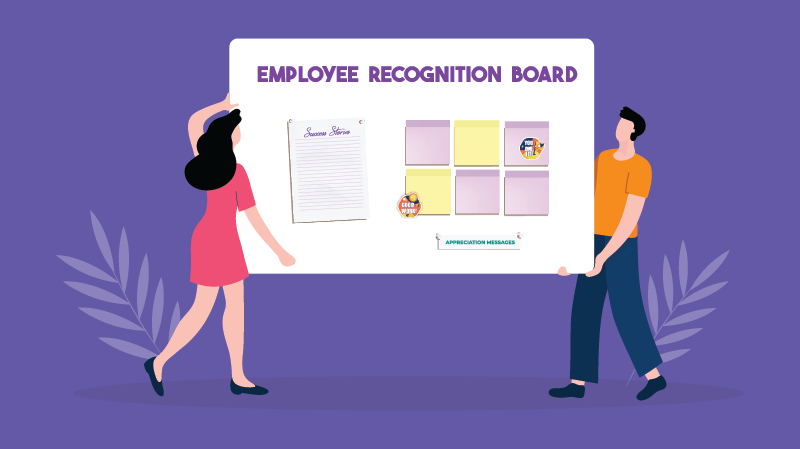25 Employee Recognition Statistics You Shouldn't Ignore in 2024
The benefits of employee recognition and its impact on successful business outcomes may be intuitively obvious to you as an HR manager. But you’d want to have some persuasive employee recognition statistics by your side to back your point.
For instance, when you plan your employee recognition program, you may begin with questions like:
- What's the effect of not having a thriving recognition culture?
- How will a successful program benefit the bottom line?
- What kind of recognition do employees prefer?
- Do they like spoken words of praise or gifts?
- Which is more meaningful to them: recognition from peers or leadership?
And so on.
This article provides you with 25 employee recognition statistics that will help answer all these questions and more. We've grouped them under different headings to make them easier to understand and organize.
- Employee Recognition Statistics Relating To Retention
- Recognition Statistics Relating to Employee Engagement
- Statistics Related To Productivity And Performance
- Statistics Relating Recognition With Company Values
- Statistics Related To Employee Satisfaction/Loyalty
- Statistics Related To Objectives Of Recognition Programs
- Statistics Related To Employees’ Preference In Recognition
- Statistics Related To Employee Recognition Tools
- Statistics Related To Peer-To-Peer Recognition
- Statistics Related To Recognition From Leadership
- Recognition Statistics Related To Business Outcomes
Employee Recognition Statistics Relating To Retention
1. 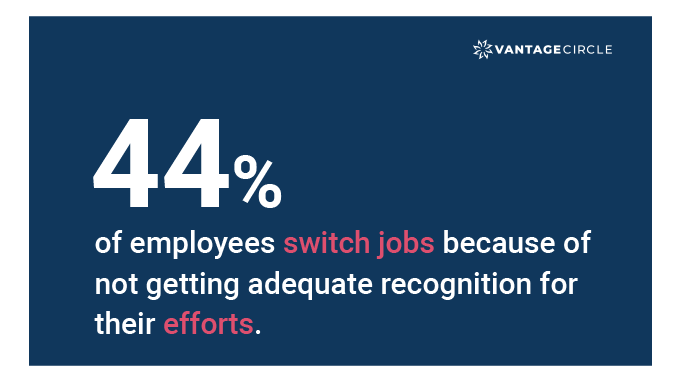
Source: Achievers
There is a clear connection between recognition and employee retention. Out of the total employees surveyed, 55% said that they are going to leave their jobs. The majority of them cited a lack of recognition by their current employer as the primary reason. In fact, 69% of them said that better employee rewards will encourage them to stay back longer.
2. 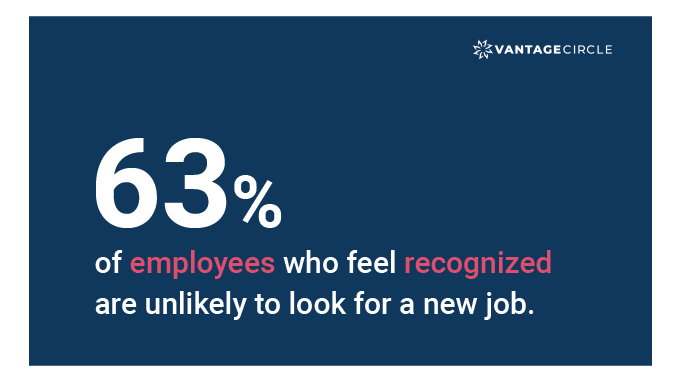
Source: Bonusly and SurveyMonkey
The respondents who are “usually” or “always” recognized for their efforts feel motivated and valued and would prefer to continue working for the company.
3. 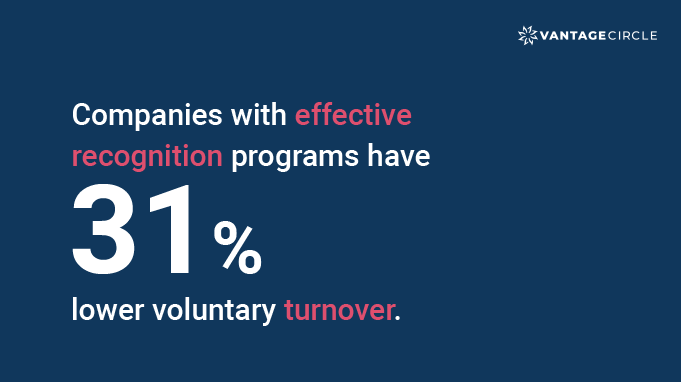
Source: Bersin & Associates
Turnover can be highly costly, with additional expenses in recruitment, onboarding, and training. So investing in a recognition program can save you the hassle.
4. 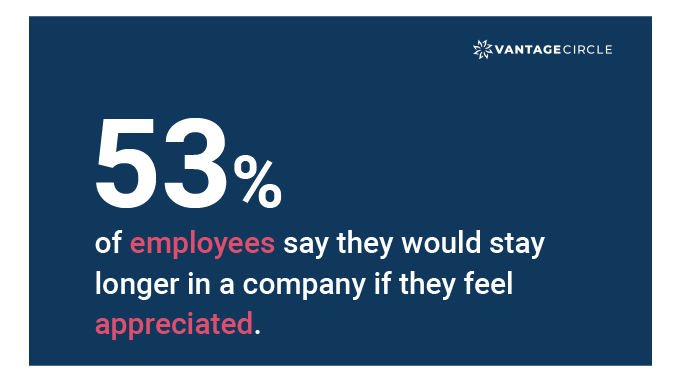
Source: Glassdoor
Employers can retain more than half of the employees simply by fostering a strong recognition culture. When employees are happy, they are less likely to leave the company. Timely rewards and recognition can be a powerful retention tool.
Recognition Statistics Relating to Employee Engagement
5. 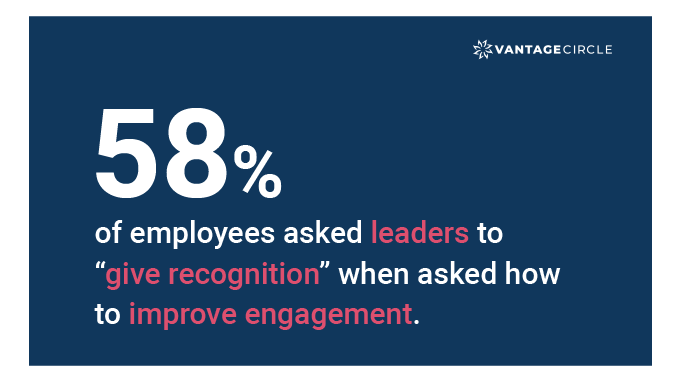
From: Psychometrics
Industry leaders realize the power that recognition holds over employee engagement. So if a company's engagement rates are low, the easiest thing they can do is start a recognition program.
6. 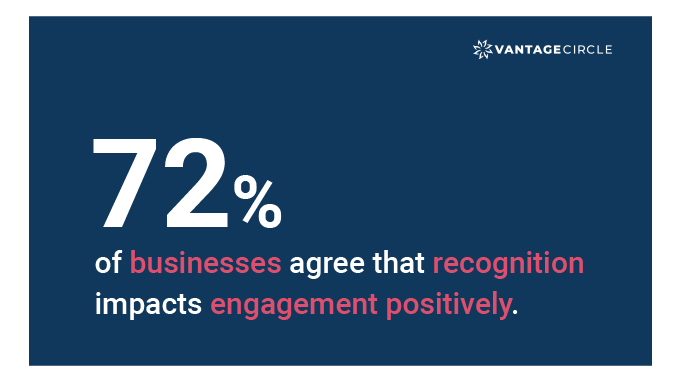
Source: Harvard Business Review
These respondents were asked about the factors critical to improving employee engagement. Almost three-quarters chose ‘recognition given to high performers’ as their top choice.
7. 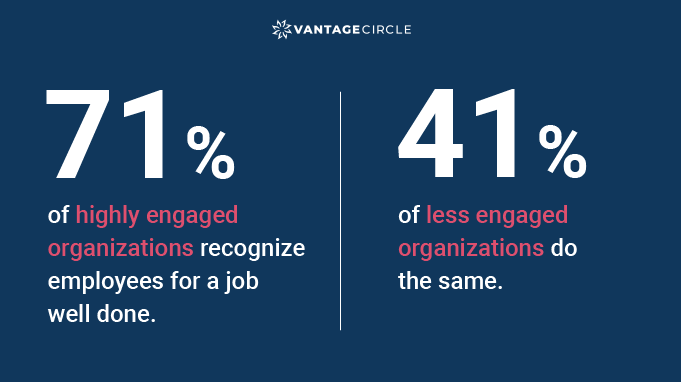
Source: Bonusly
In a highly engaged working environment, people are fully committed to their work. They take discretionary efforts to achieve company goals and appreciate others when they do the same. Thus, high engagement fuels a culture of appreciation for each other's contributions.
Statistics Related To Productivity And Performance
8. 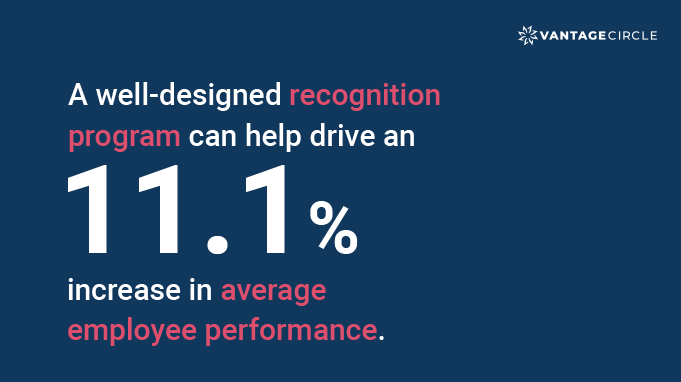
Source: Gartner
Recognition is one of the best positive feedbacks employees can get for their performance. They realize they are on the right track and that their actions align with company goals. Hence, they continue to give their very best. It also motivates other employees to strive harder to achieve their goals.
9. 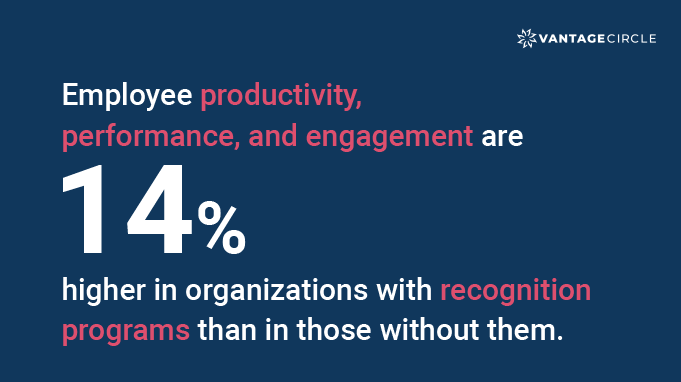
Source: Deloitte
There’s no doubt that recognition can drive productivity. When there is an award up for grabs, employees try hard to do their assigned tasks in the best possible way. It extrinsically motivates the workforce to be more productive.
10. 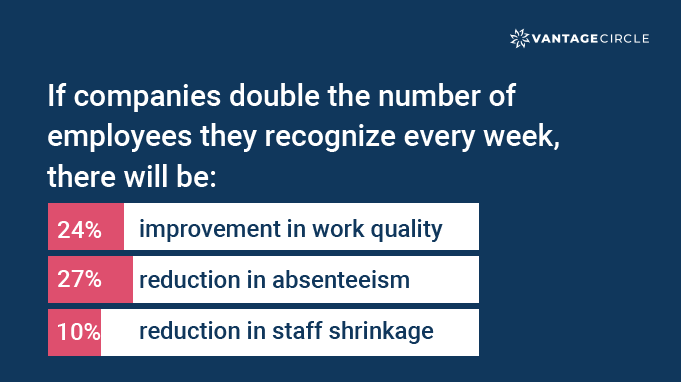
Source: Gallup
These have a direct impact on higher employee engagement and productivity levels.
Staff shrinkage refers to the inventory loss due to employee theft, shoplifting, errors, fraud, etc.
Statistics Relating Recognition With Company Values
11. 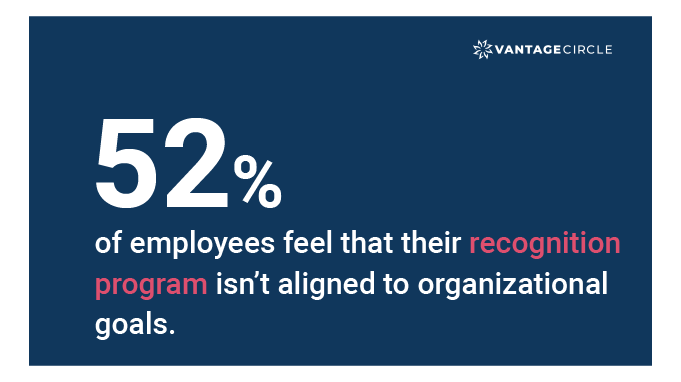
Source: Deloitte
Employee recognition cannot be limited to typical measures like an occasional gift or long service awards. It needs to be an integral part of the company culture with its objectives aligned with company values. Only then can you see if recognition programs make an actual difference to the engagement levels.
12. 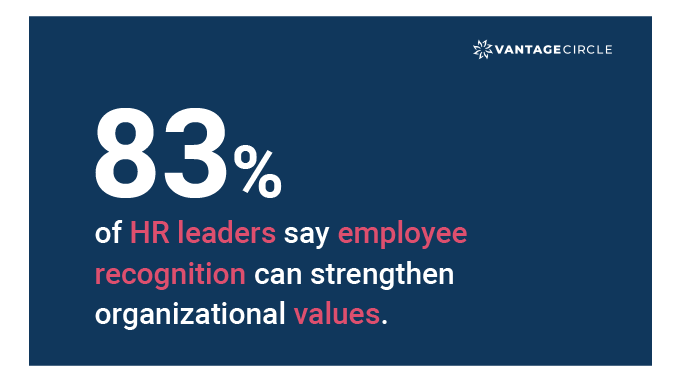
Source: Globoforce
Successful companies design recognition programs that are aligned with their core values. When an employee notices a particular behavior being frequently recognized, they understand what the company expects. They associate that action with getting rewarded. It becomes more likely that they continue to do it in the future, thereby strengthening company values.
Statistics Related To Employee Satisfaction/Loyalty
13. 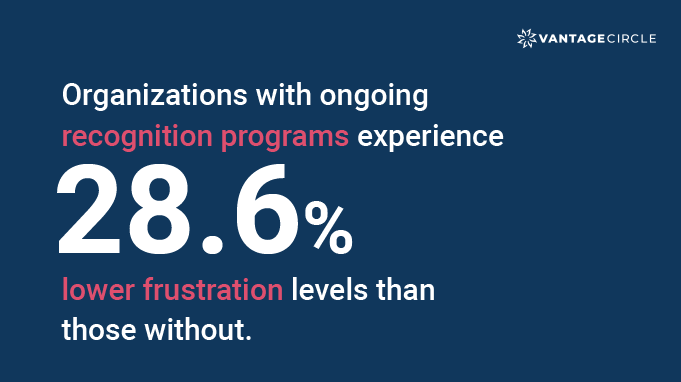
Source: SHRM/Globoforce
Getting appreciated creates ‘oxytocin’ in the body. Research says people under the influence of this ‘love hormone’ experience reduced stress and perform better.
When a person achieves a goal, they feel excited and satisfied. This excitement of achieving the goal is amplified when others recognize their achievements. Employee morale rises when people feel good about the work they do.
14. 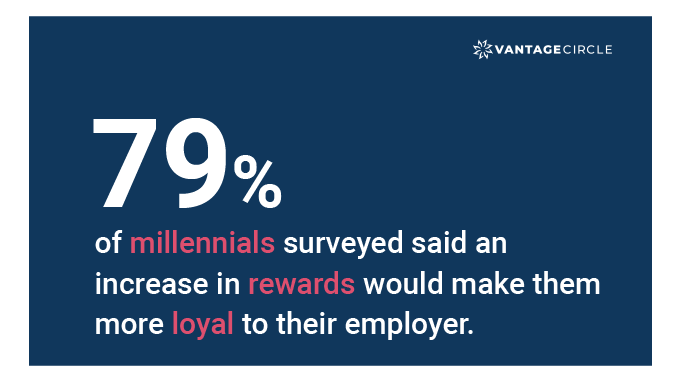
Source: SHRM
Most employers have the tendency to think of millennials as unpredictable. But studies show that this group can become an organization’s most valuable asset when appreciated in the right manner.
Millennials are a fast-paced generation who look for timely recognition. They are more likely to stay with the company if they feel truly valued.
Statistics Related To Objectives Of Recognition Programs
15. 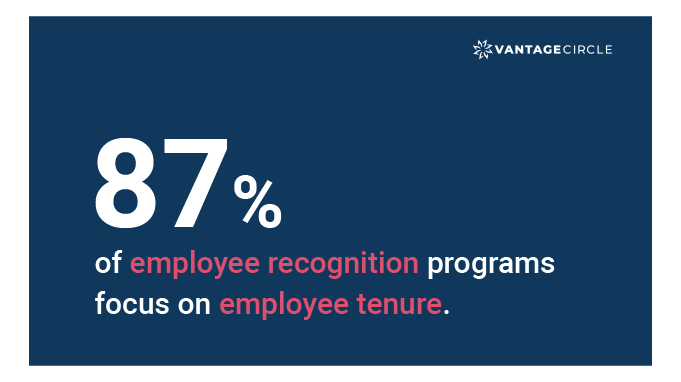
From: Bersin & Associates
Long-term employees deserve to be appreciated for their loyalty and dedication. But tenure shouldn’t be the only thing that ought to be celebrated about your employees. The US Bureau of Labor Statistics found that employees today are staying engaged with businesses for shorter periods.
Recognition needs to move beyond tenure and focus on the value an employee brings to work. It can be for day-to-day tasks, teamwork efforts, ideal behaviors, or simply for the way they do things. If they do a great job, you should let them know on the spot.
Statistics Related To Employees’ Preference In Recognition
16. 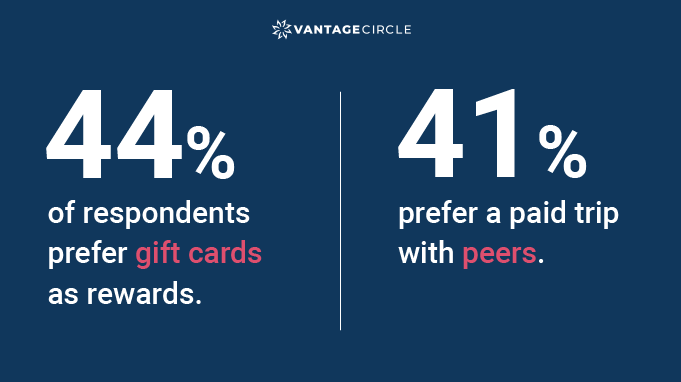
Source: Bonusly
Employee preferences matter when you want to show authentic and impactful recognition. Each employee is unique. What might motivate one won’t necessarily motivate others. So it is necessary to take into account what they put value in.
With gift cards, employees have the choice to get the things they wish to buy. Recognition tools like Vantage Rewards offer points-based reward systems where points are tied to a specific monetary value. These points are usually redeemable from gift cards.
17. Men and women have different reward and recognition experiences.
Source: BambooHR
A study by BambooHR of 1700 respondents reports gender disparities in the frequency and type of recognition received.
For example:
-
50% of men surveyed said they receive recognition frequently compared to 43% of women. Since the study finds no data that says men are outperforming women, the gap is troubling.
-
Men appear to receive gifts of higher value than women. Twice as many men receive gifts worth $100-500 and $500-1000. On the other hand, twice as many women receive gifts worth less than $10.
Statistics Related To Employee Recognition Tools
18. 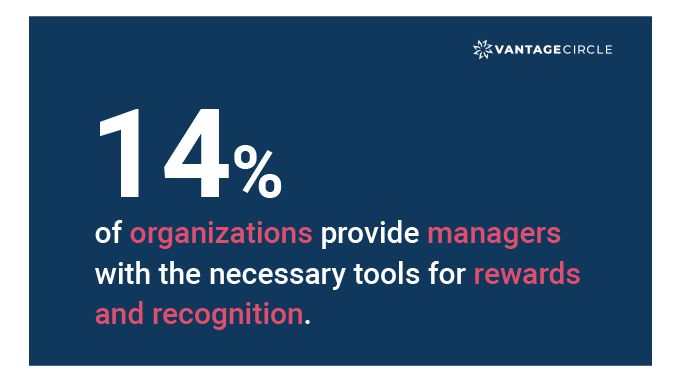
Source: Globoforce
We can clearly see that recognition impacts engagement, retention, and productivity levels positively. But companies are not providing the necessary tools required to effectively recognize employees. Providing recognition tools can make it easier for peers to recognize each other. Managers can reach out to remote employees to celebrate their work.
SaaS-based tools like Vantage Rewards are helping people recognize each other instantly, even while on the go.
Statistics Related To Peer-To-Peer Recognition
19. Peers, not money, are the number one motivator in driving colleagues to work harder.
From: TINYpulse
This research found that peer recognition is a top factor that pushes employees to go the extra mile. When peers recognize each other’s contributions, it strengthens their relationship and builds trust. Employees feel more connected to the team, making collaboration more effective.
For instance, an employee stays back late to support another with their work. Acknowledging such genuine effort in front of the team members can boost one’s intrinsic motivation to do good work. This ultimately increases engagement and retention levels.
20. 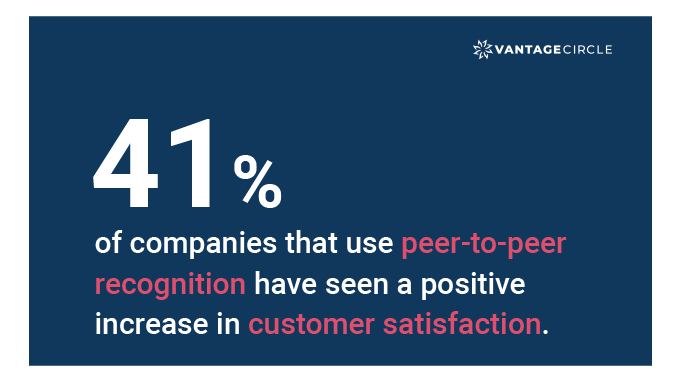
From: Globoforce
When organizations invest in building a strong culture of recognition, satisfaction levels rise. People are motivated, happy, and energized. They become inspired to be more productive and proactive. They take charge of their duties, make an effort to solve problems, and ensure the best customer service.
Statistics Related To Recognition From Leadership
21. 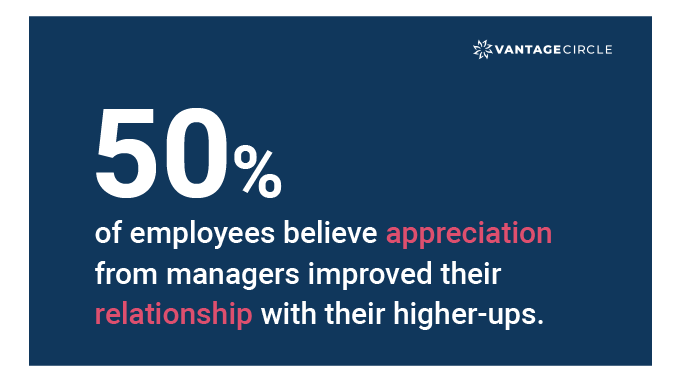
From: Cicero Group
Providing appreciation to employees for their efforts helps build stronger relations between the employer and employee. It can be a pat on the back, a personalized note, a gift, or even a free reign over what they do. Recognition is a way to let employees know that you trust and value them.
22. 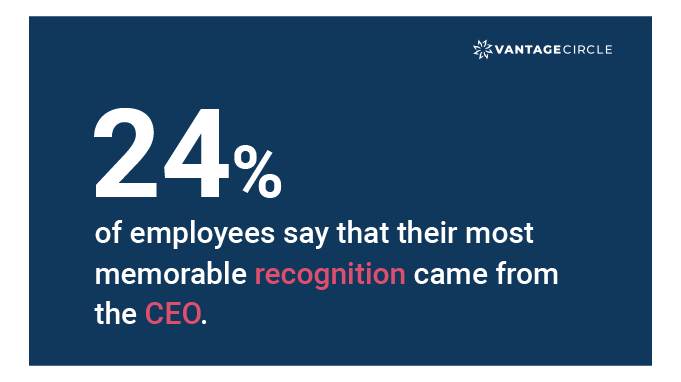
Source: Gallup
A high-ranking leader taking the time to show appreciation can yield a positive impression on an employee. Leaders praising the dedication, effort, or achievements of employees can significantly impact morale and engagement.
23. 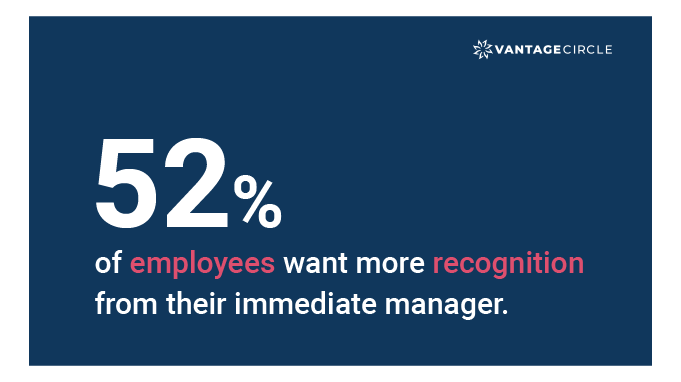
Source: Quantum Workplace & BambooHR
Managers know their team inside and out. So recognition from one's manager can prove to be the most authentic appreciation. Managers are also more likely to know what type of recognition will appeal to the employee.
In her book "Make Their Day", Cindy Ventrice says that teams respond more to the acknowledgment from immediate managers than that from senior leadership.
Recognition Statistics Related To Business Outcomes
24. 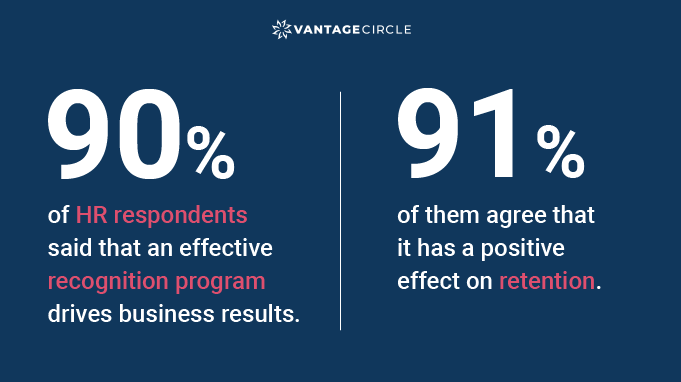
Source: Reward Gateway
This study also reveals that a lack of recognition is one of the top reasons employees don’t feel motivated. And being unmotivated leads to lower productivity, a drop in work quality, and eventual burnout.
25. 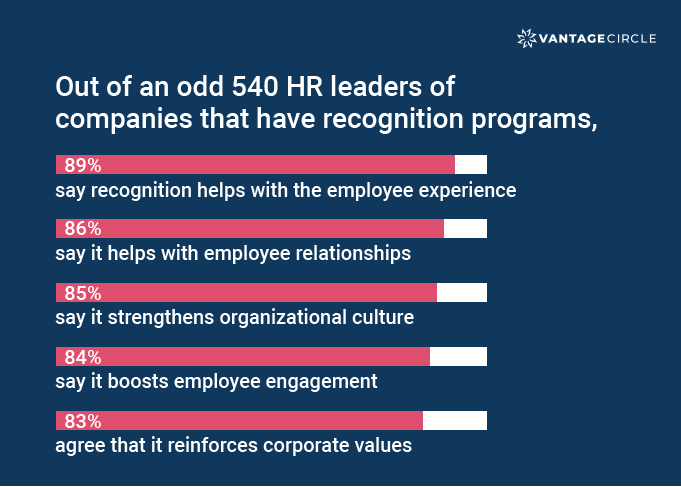
Source: Globoforce
Final Thoughts
Currently, the world of work is going through several changes. We have an expanding millennial workforce that genuinely believes that good work deserves timely recognition. Meanwhile, companies are engaged in a competitive war for talent as the demand for specialized workforce increases. Having a culture of recognition not only helps retain employees but helps attract top talent.
Moreover, we have global crises like pandemics causing mass-scale volatility, uncertainty, and stress. Now more than ever, hard-working employees deserve to feel appreciated.
Recognition is no longer just a nice thing to have in a company. It is a powerful business strategy that companies like Zappos and Apple use to curb attrition and improve retention.
The above statistics make a strong case for why companies need to invest in an employee recognition program. It’s time you double down on your recognition efforts too. Invest in the right tools and the right talent, and make your way towards a flourishing culture of recognition.












